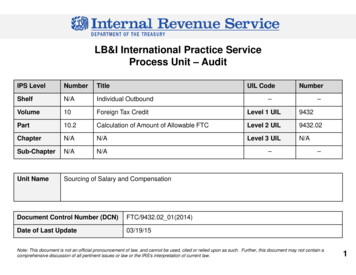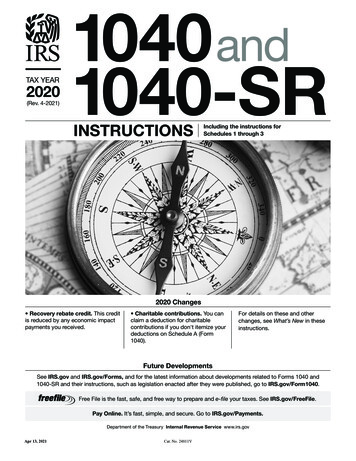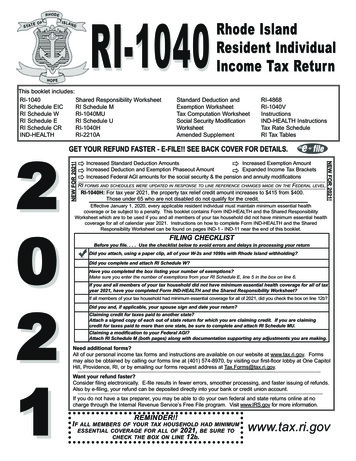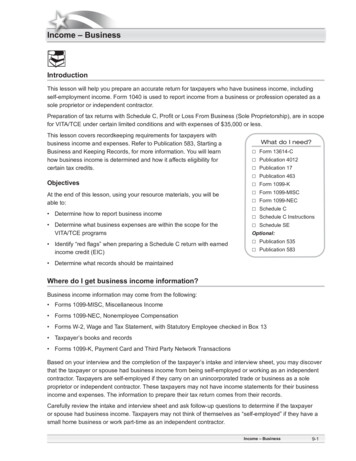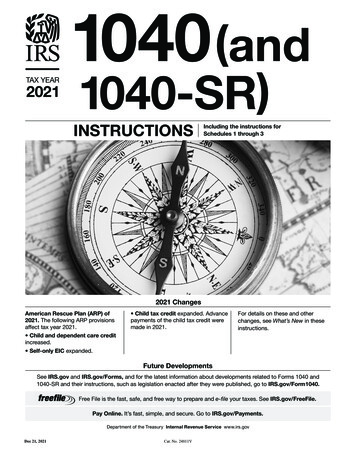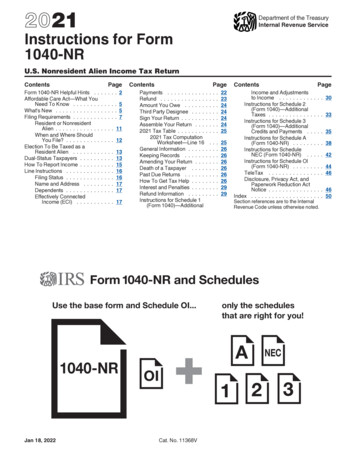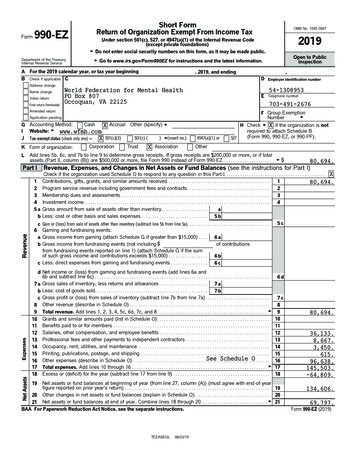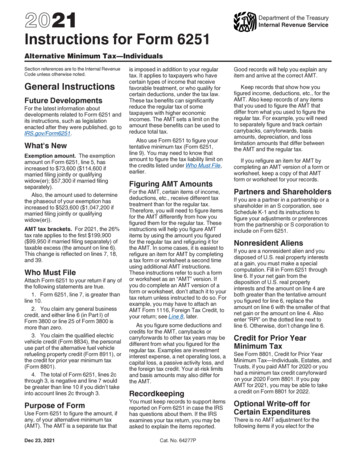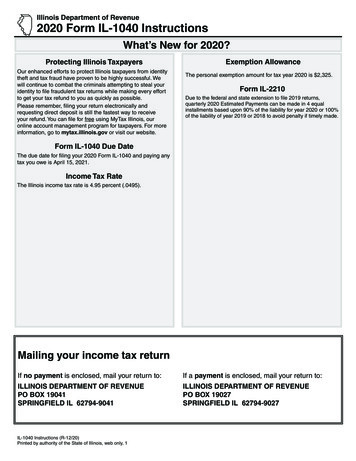
Transcription
Illinois Department of Revenue2020 Form IL-1040 InstructionsWhat’s New for 2020?Protecting Illinois TaxpayersOur enhanced efforts to protect Illinois taxpayers from identitytheft and tax fraud have proven to be highly successful. Wewill continue to combat the criminals attempting to steal youridentity to file fraudulent tax returns while making every effortto get your tax refund to you as quickly as possible.Please remember, filing your return electronically andrequesting direct deposit is still the fastest way to receiveyour refund. You can file for free using MyTax Illinois, ouronline account management program for taxpayers. For moreinformation, go to mytax.illinois.gov or visit our website.Exemption AllowanceThe personal exemption amount for tax year 2020 is 2,325.Form IL-2210Due to the federal and state extension to file 2019 returns,quarterly 2020 Estimated Payments can be made in 4 equalinstallments based upon 90% of the liability for year 2020 or 100%of the liability of year 2019 or 2018 to avoid penalty if timely made.Form IL-1040 Due DateThe due date for filing your 2020 Form IL-1040 and paying anytax you owe is April 15, 2021.Income Tax RateThe Illinois income tax rate is 4.95 percent (.0495).Mailing your income tax returnIf no payment is enclosed, mail your return to:If a payment is enclosed, mail your return to:ILLINOIS DEPARTMENT OF REVENUEILLINOIS DEPARTMENT OF REVENUEPO BOX 19041 PO BOX 19027SPRINGFIELD IL 62794-9041SPRINGFIELD IL 62794-9027IL-1040 Instructions (R-12/20)Printed by authority of the State of Illinois, web only, 1
Tips To Speed Up The Processing Of Your Return File your return electronically! Visit mytax.illinois.govor see your tax professional.Enter your correct Social Security number (SSN) andname. If you are married, you must include your spouse’sSSN and name.If you received federally taxed Social Security benefits orqualified retirement income, you may be able to subtract iton Line 5. See the Line 5 Instructions for details.Attach a completed Schedule IL-WIT and all withholdingforms (W-2s, 1099s, etc.) to support the amount you claimas Illinois Income Tax withheld on Line 25.Enter the correct amount of estimated payments youmade, including any overpayment applied from a prior yearreturn. You may verify the amount using the estimatedpayment inquiry on our website. Include any required attachments (e.g., Schedule M,Schedule ICR, Schedule IL-E/EIC, Schedule CR, federalForm 1040 and Schedules) with your Form IL-1040.Make sure to have any support documentation available ifrequested.If you are claiming a property tax credit, you must enter thecounty in which your property is located and the propertynumber on Schedule ICR, Illinois Credits.If you enter an amount you want refunded to you onLine 36, you must check one box on Line 37 to indicatehow you would like us to issue your refund. You may selectdirect deposit, refund debit card, or paper check.Review the entries you made on each line for accuracyand verify your calculations.Sign your return.Table of ContentsGeneral InformationFrequently Asked Questions and Information3-5Who must file an Illinois tax return?3-4Who is an Illinois resident?4What is Illinois income?4How may I file?4When must I file?4Should I round?4Will I owe penalties and interest?What if I cannot pay?5When must I file an amended return?5What if I have household employees?5What if I change my address?5What if I am in a civil union?5What if I am an injured spouse?5What if I participated in a potentially abusivetax avoidance transaction?5File a decedent’s return6Filing status6File household employment tax using Form IL-10409Pay use tax using Form IL-10409 - 10Refund options14Payment options15Step-by-Step InstructionsAllocation WorksheetInformation and Assistance24-56 - 161718 - 19tax.illinois.gov
General InformationWho must filean Illinoistax return?If you were an Illinois resident, you must file Form IL-1040 ifyou were required to file a federal income tax return, oryou were not required to file a federal income tax return, but your Illinois base income from Line 9 isgreater than your Illinois exemption allowance. an Illinois resident who worked in Iowa, Kentucky, Michigan, or Wisconsin, you must fileForm IL-1040 and include as Illinois income any compensation you received from an employer in thesestates. Compensation paid to Illinois residents working in these states is taxed by Illinois. Based onreciprocal agreements between Illinois and these states, these states do not tax the compensation ofIllinois residents.If your employer in any of these states withheld that state’s tax from your compensation, you may file thecorrect form with that state to claim a refund. You may not use tax withheld by an employer for thesestates as a credit on your Illinois return. a retired Illinois resident who filed a federal return, you must file Form IL-1040. However, certaintypes of retirement income (e.g., pension, Social Security, railroad retirement, governmental deferredcompensation) may be subtracted from your Illinois income. For more information, see the instructions forLine 5 and Publication 120, Retirement Income. a part-year resident, you must file Form IL-1040 and Schedule NR, Nonresident and Part-YearResident Computation of Illinois Tax, ifyou earned income from any source while you were a resident,you earned income from Illinois sources while you were not a resident, oryou want a refund of any Illinois Income Tax withheld. a nonresident, you must file Form IL-1040 and Schedule NR ifyou earned enough taxable income from Illinois sources to have a tax liability (i.e., your Illinois baseincome from Schedule NR, Step 5, Line 46, is greater than your Illinois exemption allowance onSchedule NR, Step 5, Line 50), oryou want a refund of any Illinois Income Tax withheld in error. You must attach a letter of explanationfrom your employer.If you are a nonresident and your only income in Illinois is from one or more partnerships,S corporations, or trusts that withheld enough Illinois Income Tax to pay your liability, you are not requiredto file a Form IL-1040. an Iowa, Kentucky, Michigan, or Wisconsin resident who worked in Illinois, you must fileForm IL-1040 and Schedule NR ifyou received income in Illinois from sources other than wages, salaries, tips, and commissions, oryou want a refund of any Illinois Income Tax withheld.If you received wages, salaries, tips, and commissions from Illinois employers, you are not required topay Illinois Income Tax on this income. This is based on reciprocal agreements between Illinois andthese states.The reciprocal agreements do not apply to any other income you might have received, such as Illinoislottery winnings and Illinois unemployment income. an Illinois resident who was claimed as a dependent on your parents’ or another person’sreturn, you must file Form IL-1040 ifyour Illinois base income from Line 9 is greater than 2,325, oryou want a refund of Illinois Income Tax withheld from your pay.If your parent reported your interest and dividend income through federal Form 8814, Parents’Election to Report Child’s Interest and Dividends, do not count that income in determining if you mustfile your own Form IL-1040.tax.illinois.gov the surviving spouse or representative of a deceased taxpayer who was required to file in Illinois,you must file any return required of that taxpayer. a student, you are not exempt from tax nor are there special residency provisions for you. However,income, such as certain scholarships or fellowships, that is not taxable under federal income tax law, isalso not taxed by Illinois. a nonresident alien, you must file Form IL-1040 if your income is taxed under federal income tax law.You must attach a copy of your federal Form 1040NR, U.S. Nonresident Alien Income Tax Return, orfederal Form 1040NR-EZ, U.S. Income Tax Return for Certain Nonresident Aliens With No Dependents.3
General InformationEven if you are not required to file Form IL‑1040, you must file to get a refund of Illinois Income Tax withheld from your pay, estimated tax payments you made, or withholding on income passed through to you by a partnership, S Corporation, or trust.Who is anIllinoisresident?You are an Illinois resident if you were domiciled in Illinois for the entire tax year. Your domicile is the place whereyou reside and the place where you intend to return after temporary absences. Temporary absences may includeduty in the U.S. Armed Forces, residence in a foreign country, out-of-state residence as a student, or out-of-stateresidence during the winter or summer.If you filed a joint federal return and one spouse is an Illinois resident while the other spouse is anonresident or a part-year resident, you may file separate Illinois returns. If you file a joint Illinois return, you willboth be taxed as residents.What isIllinoisincome?Your Illinois income includes the adjusted gross income (AGI) amount figured on your federal return, plus anyadditional income that must be added to your AGI. Some of your income may be subtracted when figuring yourIllinois base income. For more information, see the Step-by-Step Instructions.You should follow the federal law concerning passive activity income and losses. You are not allowed to refigureyour federal passive activity losses.Also, federal law will govern the taxation of income from community property sources in the case of spouses whofile joint federal returns and who file separate Illinois returns.How mayI file?File your individual income tax return electronically by using MyTax Illinois, available on our website for free, a tax professional, or tax preparation software.Almost all taxpayers can file electronically. Visit mytax.illinois.gov or see your tax professional. If you do not wishto file electronically, you may use the paper Form IL-1040.When mustI file?Your Illinois filing period is the same as your federal filing period. We will assume that you are filing yourForm IL-1040 for calendar year 2020 unless you are filing for a fiscal year and indicate a different filing period inthe space provided at the top of the return. The due date for calendar year filers is April 15, 2021.We grant an automatic six-month extension of time to file your return. If you receive a federal extension of morethan six months, you are automatically allowed that extension for Illinois. These extensions do not grant you anextension of time to pay any tax you owe. If you determine that you will owe tax, you must use Form IL-505-I,Automatic Extension Payment for Individuals, to pay any tax you owe to avoid penalty and interest on tax not paidby April 15, 2021.Should Iround?You must round cents to whole dollars on Form IL-1040 and most schedules, as directed. To round you must drop amounts under 50 cents and increase amounts of 50 to 99 cents to the next dollar.For example, 1.49 becomes 1 and 2.50 becomes 3.If you have to add two or more amounts to figure the amount to enter on a line, include cents when adding theamounts and round only the total.Will I owepenaltiesandinterest?4You will owe a late-filing penalty if you do not file a return that we can process by the extended due date. a late-payment penalty for tax not paid by the original due date of the return. a late-payment penalty for underpayment of estimated tax if you were required to make estimated taxpayments and failed to pay the required amount by the payment due dates. a bad check penalty if your remittance is not honored by your financial institution. a cost of collection fee if you do not pay the amount you owe within 30 days of the date printed onany IDOR-2-BILL, Final Notice of Tax Due for Form IL-1040, Individual Income Tax Return, you receive.tax.illinois.gov
General Information a frivolous return penalty if you file a return that does not contain information necessary to figure thecorrect tax or shows a substantially incorrect tax, because you are taking a frivolous position or are tryingto delay or interfere with collection of the tax.interest on unpaid tax from the day after the original due date of your return through the date you paythe tax.We will bill you for penalties and interest. For more information about penalties and interest, seePublication 103, Penalties and Interest for Illinois Taxes.What ifI cannotpay?If you cannot pay the tax you owe but you can complete your return on time, file your return by the duedate without the payment. This will prevent a late-filing penalty from being assessed. You will, however, owea late-payment penalty and interest on any tax you owe after the original due date, even if you have anextension of time to file.You have the option to pay the amount you owe electronically by using our website or by credit card. See theinstructions for Line 39.When mustI file anamendedreturn?Do not file another Form IL-1040 to make changes to a previously filed Form IL-1040. You must fileForm IL-1040-X, Amended Individual Income Tax Return, if you discover that you made an error on your Illinois return after it was filed, oryour federal return has been adjusted either by the Internal Revenue Service (IRS) or on a federalForm 1040X, Amended U.S. Individual Income Tax Return, you filed; the change affects your Illinoisincome, additions, subtractions, exemptions, or credits; and the change is final.If the federal change results in a refund, do not file Form IL-1040-X until you receive notificationthat your change has been accepted by the IRS.For more information, see Form IL-1040-X and Instructions.What if I havehousehold employees?You may use Form IL-1040 to pay your household employees’ Illinois withholding. For more details on how topay withholding for your employees, see the instructions for Line 20.What if I change myaddress?If you change your address after you file, visit our website or call us to tell us your new address and the dateyou moved.What if I am in acivil union?If you are in a civil union, you must file your Illinois return using the same filing status as on your federalreturn.What if I am aninjured spouse?If you are married and you filed a joint federal return with your spouse and you are an injured spouse (e.g.,your spouse owes a liability, for which you are not responsible, to a government agency), you may elect to fileseparate Illinois returns using the “married filing separately” filing status. You may make this election up untilthe extended due date of your return, and once the election is made, it is irrevocable for the tax year.If you file a joint Illinois return, we may take the entire refund to pay your spouse’s liability.What if I participatedin a potentiallyabusive taxavoidancetransaction?tax.illinois.govIf you participated in a reportable transaction, including a “listed transaction,” during this tax year and wererequired to disclose that to the IRS, you are also required to disclose that information to Illinois.You must send us two copies of the form you used to disclose the transaction to the IRS. You must attach one copy to your tax return, and mail a second copy to the Illinois Department of Revenue,P.O. Box 19029, Springfield, Illinois 62794-9029.Employee benefit plans and other subtractions allowed on Form IL-1040, Lines 5 through 7, arenot reportable transactions. For more information, contact the IRS or your tax professional.5
Lines A-DStep 1Step-by-Step InstructionsPersonal InformationLine AName, year of birth, Social Security number, and addressPrint your full name, year of birth (YYYY), Social Security number(SSN), and address. If you are married and filing a joint return, printboth names, years of birth, and SSNs as they appear on your federalreturn. If you are married and filing separate returns, print your fullname and SSN and your spouse’s full name and SSN if you have it.Also include the Illinois county you lived in as of 12/31/2020. If youwere an Illinois resident during any part of the year but are no longerliving in Illinois, enter the county name you lived in while an Illinoisresident. If you did not live in Illinois during the tax year, leave thecounty name blank.If you do not qualify for a SSN and were issued anIndividual Taxpayer Identification Number (ITIN) by the IRS,enter your ITIN.Do not redact your SSN as it can cause processing delays.Filing a decedent’s returnWhen you are filing a joint return as a surviving spouse print your name and your spouse’s name on theappropriate lines. write “deceased” and the date of death above yourspouse’s name. sign your name in the area provided for your signature,and write “filing as surviving spouse” in place of thedecedent’s signature.If you, as the surviving spouse, are due a refund, the refundwill be issued directly to you. You are not required to completeForm IL-1310, Statement of Person Claiming Refund Due aDeceased Taxpayer.When you are filing a return on behalf of a single deceasedtaxpayer print the name of the taxpayer on the appropriate line. write “deceased” and the date of death above thedecedent’s name. write “in care of,” and the executor’s name and address.A personal representative, such as an executor or administrator,must sign and date the return. The representative’s title andtelephone number must be provided.If you are filing a return on behalf of a single deceasedtaxpayer and a refund is due, attach Form IL-1310, Statement ofPerson Claiming Refund Due a Deceased Taxpayer.Line BFiling statusIn general, you should use the same filing status as on your federalreturn. However, if you file a joint federal return and you are an injured spouse(your spouse owes a liability, for which you are notresponsible, to a government agency), you should file separateIllinois returns using the “married filing separately” filing status.Do not recalculate any items on your federal return. Instead,you must divide each item of income and deduction shown onyour joint federal return between your separate Illinois returnsfollowing the Allocation Worksheet on Page 17.You may choose to file separately as an injured spouse only untilthe extended due date of the return, and once you choose afiling status, the decision is irrevocable for the tax year. If you choose to file a joint Illinois return, we may takethe entire refund to pay your spouse’s liability.if you file a joint federal return and one spouse is a full-yearIllinois resident while the other is a part-year resident or anonresident (e.g., military personnel), you may choose tofile “married filing separately.” Do not recalculate any items onyour federal return. Instead, you must divide each item of incomeand deduction shown on your joint federal return between yourseparate Illinois returns following the Allocation Worksheet onPage 17.If you choose to file a joint Illinois return, you must treat bothyour spouse and yourself as residents. This election isirrevocable for the tax year. You may be allowed a creditfor income tax paid to another state on Schedule CR, Creditfor Tax Paid to Other States. For more information, see theSchedule CR Instructions.Line CDependent statusIf someone else can claim you, or your spouse if you are married andfiling a joint return, as a dependent, check the corresponding box.Line DResident statusIf you are filing your return as a nonresident of Illinois, check theNonresident box. If you are filing your return as a part-year residentof Illinois, check the Part-year resident box. Be sure to complete andattach Schedule NR to your IL-1040.Schedule NRForeign addressesEnter your street address on the “Mailing address” line. apartment number, if applicable. city, province or state, and postal code on the “City, State,ZIP” lines in that order. Follow the country’s practice forentering the postal code. country name on the “Foreign Nation” line. Do notabbreviate the country name.6tax.illinois.gov
Lines 1-9Step 2IncomeLine 1Adjusted gross incomeEnter the adjusted gross income from your federal return. If youare not required to file a federal income tax return, use a federalForm 1040 as a worksheet to determine your adjusted gross income.Net operating loss (NOL)If you have a federal NOL this year, you may enter anegative amount on Line 1. However, you must reduce theamount you enter on your 2020 Form IL-1040, Line 1, by anyNOL that you carry back to prior years.If you deducted an NOL carryforward on your federal returnfor this year and some of that NOL remains available to carryforward to next year, the amount on Line 1 should be yourfederal adjusted gross income calculated without deductingthe NOL carryforward, minus the amount of “Modified TaxableIncome” on Line 8 of the federal Worksheet for NOL Carryoverfound in Table 1 of IRS Publication 536, Net Operating Losses(NOLs) for Individuals, Estates, and Trusts.Line 2Federally tax-exempt incomeLine 3Other additionsComplete Schedule M if you have any of the following items: your child’s federally tax-exempt interest and dividend income asreported on federal Form 8814 a distributive share of additions you received from a partnership,S corporation, trust, or estate Lloyd’s plan of operation loss, if reported on your behalf on FormIL-1065, and included in your adjusted gross income earnings distributed from IRC Section 529 college savingsand tuition programs and ABLE plans if these earnings are notincluded in your adjusted gross income, Line 1 an addition amount calculated on Form IL-4562, SpecialDepreciation business expense recapture (nonresidents only) recapture of deductions for contributions to Illinois collegesavings plans and ABLE plans transferred to an out-of-state plan credit received on Schedule 1299-C for student-assistancecontributions made as an employer on behalf of your employees deductions claimed in prior years for college savings plan andABLE plan contributions if you made a nonqualified withdrawalthis tax year any other amounts that you are required to add to your federaladjusted gross incomeFor more information, see the Schedule M Instructions.Enter the amount of federally tax-exempt interest and dividendincome reported on federal Form 1040, U.S. Individual Income TaxReturn, Line 2a.Schedule M and any required supporting documents.Your distributive share of federally tax-exempt interest anddividend income received from a partnership, S corporation, trust, orestate is added back on Schedule M, Line 2.Step 3Base IncomeLine 5Social Security benefits and certain retirement plansEnter the amount of federally taxed Social Security and retirementincome included in your adjusted gross income on Form IL-1040,Line 1 that you received from qualified employee benefit plans (including railroad retirementand 401(K) plans) and Individual Retirement Accounts or selfemployed retirement plans reported on federal Form 1040 or1040-SR, Line 4b and 5b. Social Security and railroad retirement benefits reported onfederal Form 1040 or 1040-SR, Line 6b. government retirement and government disability plansand group term life insurance premiums paid by a qualifiedretirement plan reported as wages on your federal Form 1040or 1040-SR, Line 1. state or local government deferred compensation plansreported on federal Form 1040 or 1040-SR, Line 1 and 5b. certain capital gains on employer securities reported on federalForm 1040 or 1040-SR, Line 7. certain retirement payments made directly to retiredpartners reported on federal Form 1040 or 1040-SR, Schedule1, Line 5.Your beneficiary share of payments from certain retirementplans and retirement payments to retired partners reported onSchedule K-1-T, Beneficiary’s Share of Income and Deductions,tax.illinois.govshould not be included on Line 5. For more information, see theSchedule M Instructions. See Publication 120 for detailed informationabout what retirement income you may subtract.Federal Form 1040 or 1040-SR, Page 1 and Schedule 1, andany W-2 and 1099 forms. If your retirement income is not reported onyour federal Form 1040 or 1040-SR, Lines 4b, 5b, or 6b, or shown onyour W-2 and 1099 forms, see Publication 120 for a list of any additionalrequired attachments.Line 6Illinois Income Tax overpaymentEnter the total amount of any Illinois Income Tax overpayment(including any amount that was credited to another tax liability)reported as income on your 2020 federal Form 1040 or 1040-SR,Schedule 1, Line 1. Do not include other states’ refunds on this line.Line 7Other subtractionsYou may be entitled to subtract other items from your income. Seethe instructions for Schedule M to see if you are eligible for othersubtractions.Schedule M and any required supporting documents.Line 9Base incomeThis line may not be less than zero. If the result is a negativenumber, enter “zero.”7
Lines 10-13Step 4Line 10bExemptionsIf you (or your spouse if married filing jointly) were 65 or older, checkthe appropriate box(es). Multiply the number of boxes checked by 1,000 and enter the amount on Line 10b.Line 10Illinois exemption allowanceSee Income Exceptions in the box on the right.Line 10cLine 10aIf you (or your spouse if married filing jointly) were legally blind, checkthe appropriate box(es). Multiply the number of boxes checked by 1,000 and enter the amount on Line 10c.See chart to figure your exemption amount for this line.Filing Status Did youcheck eitherbox on Step1, Line C?Baseincome fromLine 9 orScheduleNR, Line 46ExemptionAmount enter thisamount onStep 4, Line10a: 2,325 2,325Single*No**any amountSingle*Yes 2,325 orbelowSingle*Yes 2,326 orgreater 0Married filingjointlyNo**any amount 4,650Married filingjointlyYes - onlyone 2,325 orbelow 4,650Married filingjointlyYes - onlyone 2,326 orgreater 2,325Married filingjointlyYes - both 4,650 orbelow 4,650Married filingjointlyYes - both 4,651 orgreater 0Line 10dIf you are claiming dependents, complete Schedule IL-E/EIC, andenter the amount from Step 2, Line 1, on Line 10d.Schedule E/EIC.**Income ExceptionsIf your federal filing status is married filing jointly and your federalAGI is greater than 500,000, you are not entitled to an exemptionallowance on Line 10. Enter “zero” on Line 10.If your federal filing status is single, head of household, marriedfiling separately, or widowed and your federal AGI is greater than 250,000, you are not entitled to an exemption allowance on Line 10.Enter “zero” on Line 10.*Single filing status includes Head of Household, Widowed, andMarried filing separately.**See Income Exceptions.Step 5Net Income and TaxLine 11Illinois residents only – Net incomeThis line may not be less than zero. If the result is a negativenumber, enter zero “0.”Nonresidents and part-year residents only – Net incomeComplete Schedule NR. Enter the amount from Schedule NR, Line51, on Line 11. This line may not be less than zero. If the result isa negative number, enter zero “0.”Be sure to check the box in Step 1, Line D, to identifywhether you were a nonresident or a part-year resident of Illinoisduring 2020.Schedule NR.Line 12Tax amountIllinois residents: Follow the instructions on the form.Nonresidents and part-year residents only: Enter your tax fromSchedule NR, Line 52.Schedule NR.Line 13Recapture of investment tax creditsIf you claimed an investment credit in a previous year, and theproperty considered in the computation of that investment credit wasdisqualified within 48 months after being placed in service, you mustcomplete Schedule 4255, Recapture of Investment Tax Credits, andenter the recapture amount on this line.Schedule 4255.8tax.illinois.gov
Lines 15-21Step 6Tax After NonrefundableCreditsIncome ExceptionsIf your federal filing status is married filing jointly and your federal AGIis greater than 500,000, you are not entitled to a property tax creditor a K-12 education expense credit.Form IL-1040, Line 15 Line 16 Line 17If your federal filing status is single, head of household, marriedcannot be greater than Line 14.Line 15Income tax paid to another state – Illinois residents andpart-year residents onlyIf you were taxed by another state on income you received while youwere an Illinois resident, you may be entitled to this credit. See theSchedule CR Instructions and Publication 111, Illinois Schedule CRfor Individuals, to see if you are eligible to take this credit.Schedule CR, Pages 1 through 3.Line 16Property tax and K-12 education expense creditfiling separately, or widowed and your federal AGI is greater than 250,000, you are not entitled to a property tax credit or a K-12education expense credit.Schedule ICR and any required supporting documents.Line 17Credit from Schedule 1299-CYou may be entitled to credits from Schedule 1299-C. See theinstructions for Schedule 1299-C and Schedule 1299-I to determine ifyou are eligible for these credits.Schedule 1299-C and any required supporting documents.You may be entitled to credit for property tax and K-12 educationexpenses you paid. See the instructions for Schedule ICR to see ifyou are eligible for these credits.Step 7Other TaxesLine 20Household employment taxEnter the amount of Illinois Income Tax you withheld from ahousehold employee. See Publication 121, Illinois Income TaxWithholding for Household Employees, for details on how to figurethe amount to withhold and report.Do not report household employee withholding here if youhave already reported or paid this amount using Form IL-941, IllinoisWithholding Income Tax Return.Line 21Use taxEnter the amount of Illinois Use Tax you owe. Use the Use Tax (UT)Worksheet or Use Tax (UT) Table to determine your use tax. Youmust make an entry on Line 21 (enter “zero” if you are not payinguse tax on Form IL-1040).If you owe more than 600 in use tax ( 1,200 for marriedfiling jointly taxpayers), you must file Form ST-44, Illinois Use TaxReturn.You cannot change the amount of Illinois Use Tax you enteron Form IL-1040 by filing a Form IL-1040-X.Do not report Illinois Use Tax here if you have alreadyreported or paid this amount using Form ST-44.What is Illinois Use Tax?Illinois Use Tax is a form of sales tax that you, as the purcha
Form IL-1040 Due Date The due date for filing your 2020 Form IL-1040 and paying any tax you owe is April 15, 2021. Income Tax Rate The Illinois income tax rate is 4.95 percent (.0495). Exemption Allowance The personal exemption amount for tax year 2020 is 2,325. Form IL-2210 Due to the federal and state extension to file 2019 returns,
